Cincinnati, University of Cincinnati, John Miller Burnam Classics Library, Choir Psalter
Italy, s. XV (with s. XVIII additions)
As most of you know, the Classics Library has shifted a number of its collections this summer. One of those collections is the rare books and manuscripts that were moved from ARB to what used to be called the Pal cage on S4. Most of the palaeography collection in turn has moved to the Scriptorium by the main Reading Room on floor 4. One day in early spring, as I was reviewing the books in the Pal cage to prepare for the move, I came upon a large size book (16 x 22 inches), an original medieval choir book on parchment with a wooden cover adorned with metal bosses and metal studs at the edges. I could not find either a title page or a call no. In fact, the book had not been cataloged and neither the classics bibliographer of more than 40 years, Mike Braunlin, nor my predecessors, Jacqueline Riley and Jean Wellington, were aware of its existence. I set out to try to solve the mystery of its provenance and date, but also its acquisitions history. I could find no information in the minutes of the UC Trustees, or in any library history, so the acquisitions history may never become fully known. We included the manuscript in the Adopt-a-Book event in Langsam in March which generated interest and a generous donation.
Regarding the identification of the manuscript, however; after some initial research, I contacted specialists I knew, in particular, Carmela Vircillo Franklin, President of the Medieval Academy of America and Professor of Medieval Latin at Columbia, who in turn contacted someone I also knew and had worked with in the past. Consuelo Dutschke is the Curator of Medieval and Renaissance Collections at Columbia University’s Rare Book & Manuscript Library. There are few more distinguished experts in the world. Dr. Dutschke identified our mystery manuscript as Italian, possibly northeastern, [from the Veneto area?], and originating in the 15th century. Below are her notes:
Choir Psalter for ferial use, with psalms, hymns and other texts (invitatories; antiphons; responsories; etc.).
Italy, s. XV with later (possibly s. XVIII) additions, including an alphabetical index to the psalms as the front pastedown (signed and dated 1728), as well as some replacement leaves (e.g., f. 68), and some added prayers (e.g., the Salve Regina at the end of the book).
One historiated initial remains: on a verso (folio not known), to open the service at compline, a 4-line initial C in white-patterned pink, set on a cusped gold ground, with blue and green acanthus leaves as terminals; the initial encloses the bust of a tonsured religious man wearing black robes (Benedictine?), holding a rosary in his right hand, and with a large wooden cross leaning against his left shoulder.
A verso //<Patri simulque filio tibique sancte> Spiritus sicut fuit sit iugiter seculum per omne Gloria. Amen. <added versicle and response; then:> Ad Magnificat antiphona, Suscepit deus Israel puerum suum sicut locutus est . . . , Ad complectorium antiphona, Miserere. Antiphona, Alleluia. In secula seculorum amen. Psalmus, Cum invocarem exaudivit me iustitie mee in tri<bulatione dilatasti michi> . . .
End of the hymn, Verbum supernum prodiens; antiphon for vespers; beginning of service for compline with Ps. 4. Note in the upper margin: Ad completorium. The bottom three lines of the leaf, but carefully maintaining the original historiated initial, are an 18th century replacement. The outlined style of the initial’s ground (very cusped) and the small flourished gold dot above the initial may point to northern (even northeastern?) Italy.
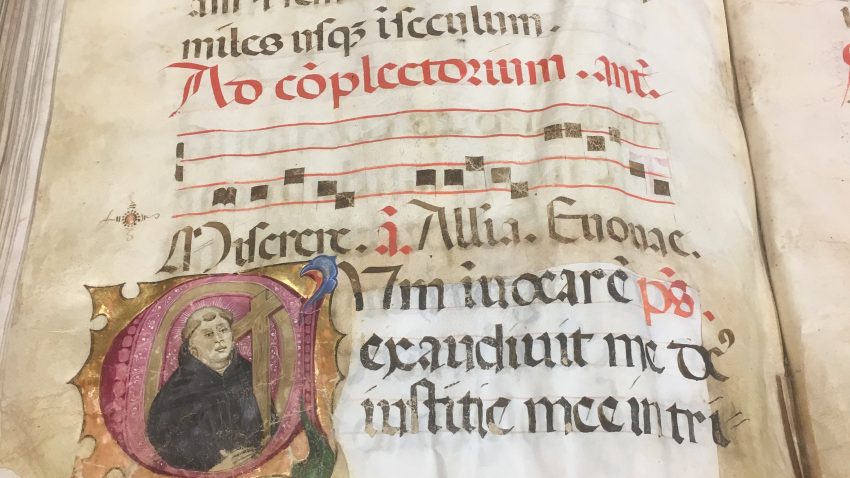
Bound in brown tooled leather over wooden boards, which are outlined in stamped metal; three bosses of an original six remain.
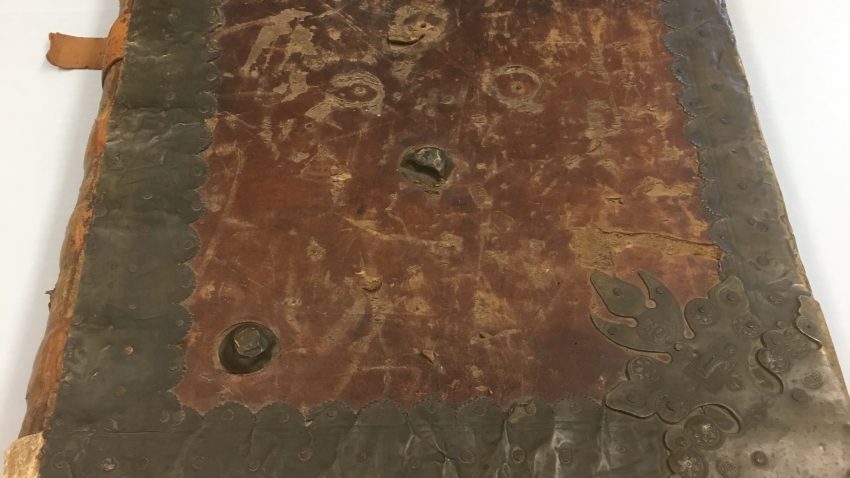
Added on the front pastedown, alphabetical list of the psalms with references to folio numbers in this volume; at the end of the list, a separate list of the psalms used in the Office of the Dead. The list is signed: “P. M. PR Fecit 1728”; the first “P” might stand for “Pater/Padre”; the “PR” might stand for “Presbyter” (?).
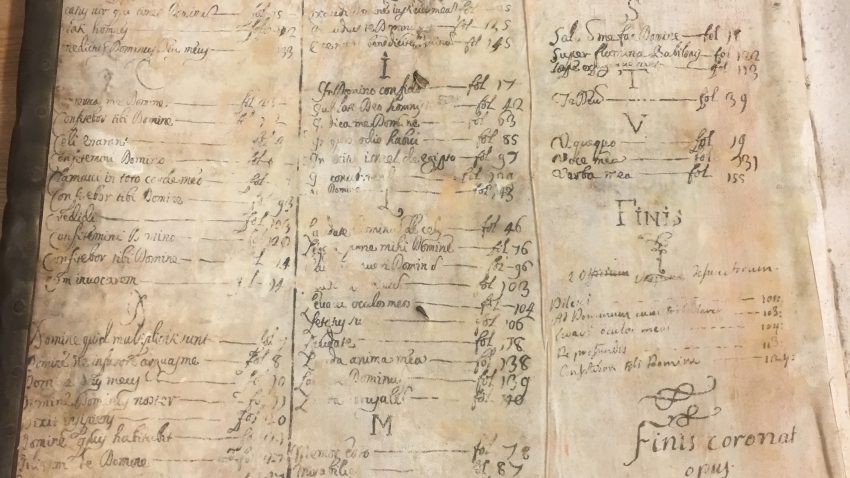
- 1 Invitatoria subscripta dicuntur singula singulis diebus dominicis a dominica prima post octavam epyphanie usque ad Septuagesimam. Et a kalendis octobris usque ad adventum. Ita tamen quod ultimum invitatorium si oportuerit repetatur. Invitatorium, Venite exultemus domino . . .
Invitatories for Sundays from the first Sunday after the octave of Epiphany until Septuagesima Sunday (basically from mid-January until February, since Septuagesima = 9th Sunday before Easter), and from the first of October until Advent (basically from early October until the end of November).
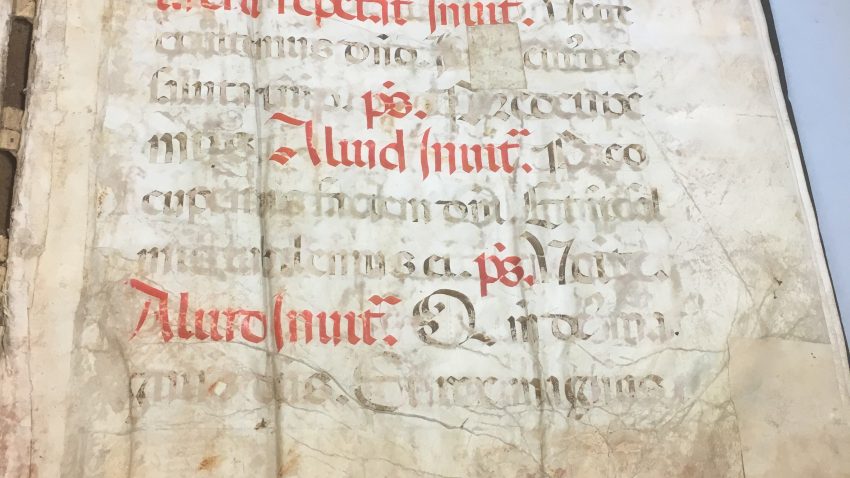
- 2 Hymns from the beginning of Lent and from the beginning of October until Advent, beginning with the hymn, Primo die quo Trinitas beata mundum condidit . . .
This first hymn for Sunday at matins; note that the second part of the line, i.e., “quo Trinitas beata mundum condidit” is a re-writing over an erasure.

- 68 Constituite diem solemnem in condempsis usque ad cornu altaris, Deus meus es tu et confitebor tibi, deus meus es tu et exaltabo te. Confitebor tibi quoniam exaudisti me et factus es mihi in salutem . . . Psalmus, Beati immaculati in via qui ambulant in lege domini, Beati qui scrutantur tes<timonia eius . . .>
End of Ps. 117 and beginning of Ps. 118; this leaf is an 18th century (probably?) replacement for the original leaf, carefully cut off along the inner bounding line that left the original penflourishing of the initials in place.
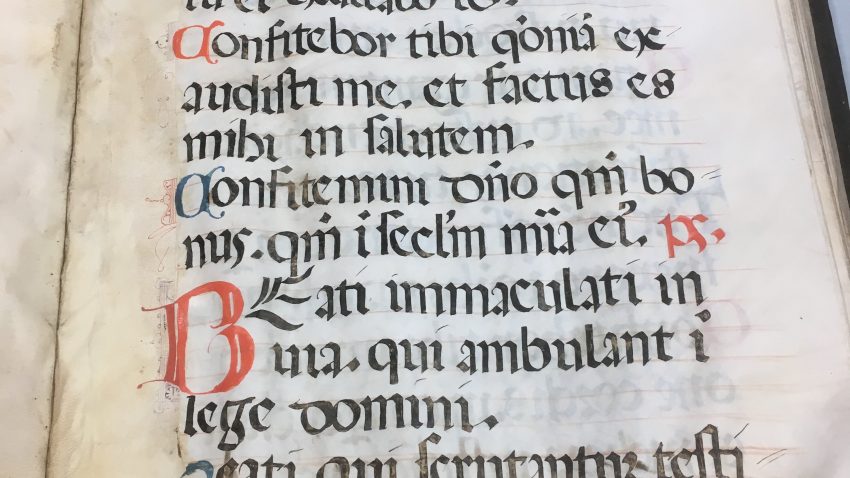
A verso //<quoniam non de>reliquisti querentes te domine. Psallite domino qui habitat in syon . . . Exultabo in salutare tuo, infixe sunt gentes in interitu//
Ps. 9, vv. 11-16; a note in a later hand in the upper margin reads “Dominica.”
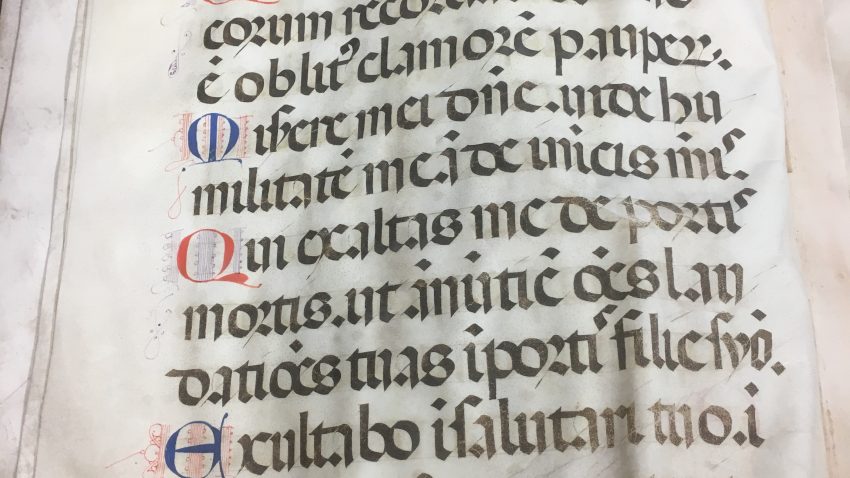
- 110 //<cum ex>ultatione portantes manipulos suos. Antiphona, Facti sumus sicut consolati. Ymnus, Telluris alme conditor mundi solum qui separans pulsis aque . . .
Ps. 125, v. 6; antiphon and hymn for Tuesday evening.
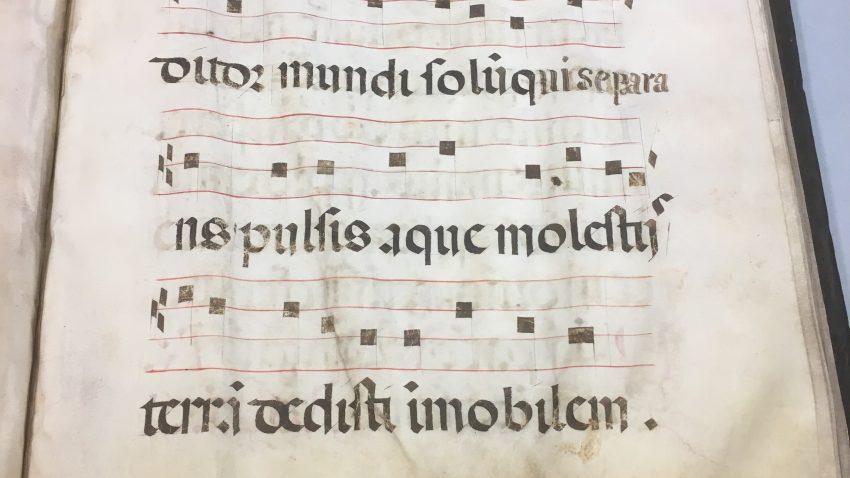
- 149v-150 Salve Regina, ending on the recto of f. 150 (but probably continuing on later pages) at “et Iesum benedictum fructum ventris”//
Added in an 18th century hand (?).
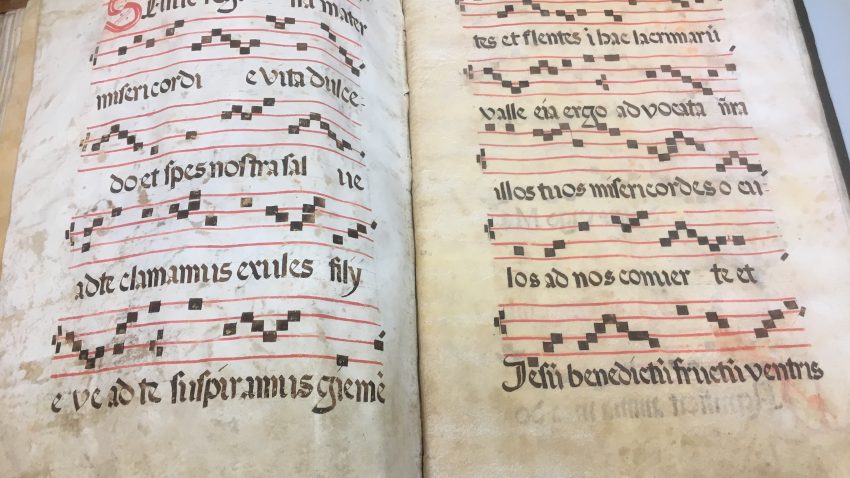
These detailed observations were made from email attachments of the images above. An in person examination will most likely yield further details. Dr. Dutschke is also one of the founders of Digital Scriptorium, a consortium of American libraries and museums whose goal is to provide inventory and detailed metadata in addition to images and, in many cases, the full text of medieval manuscripts. It is our hope that our manuscript will soon be digitized and included in the DS. However, most importantly, although the manuscript is in surprisingly good physical condition, the UCL Preservation Department will first need to stabilize the red rotted leather binding and clean the text blocks.
It was an exciting find in an obscure corner of our Library where no one knew of its existence until just a few months ago. Thanks to Professor Franklin and Dr. Dutschke and to the anonymous donor who gave us the financial support we needed, we will now be able to catalog and formally add this magnificent 15th century Italian choir book to the John Miller Burnam Classics Library’s manuscript collection.
